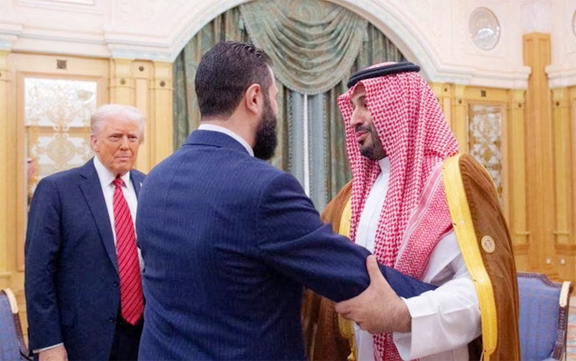DE News Desk :
Former U.S. President Donald Trump’s high-stakes tour of Saudi Arabia, Qatar, and the United Arab Emirates has signaled a dramatic realignment in Middle East diplomacy, with Washington recalibrating its regional priorities — and placing increasing distance between itself and Israeli Prime Minister Benjamin Netanyahu.
What began as a four-day journey to deepen business, defense, and technology ties with Gulf monarchies has turned into a strategic pivot that reshapes long-held alliances, sidelines Israel from center stage, and underscores America’s evolving vision for the region.
Central to the shift was Trump’s unexpected meeting with Syria’s new Islamist leader Ahmed al-Sharaa — a figure Israel labels a “dressed-up al-Qaeda terrorist.” The meeting, facilitated by Saudi hosts, and Trump’s endorsement of Sharaa as “a real leader” encapsulated the growing divergence between Washington and Tel Aviv.
Multiple regional and Western diplomatic sources say the message from Trump’s administration was unmistakable: U.S. interests in the Middle East are changing, and Netanyahu can no longer rely on unconditional support.
Diplomatic Friction with Israel Grows
Tensions between the U.S. and Israel had been simmering even before Trump’s Gulf trip, particularly over Netanyahu’s ongoing war in Gaza and his staunch opposition to renewed U.S. nuclear diplomacy with Iran. Despite being one of Trump’s earliest visitors after his return to office in January, Netanyahu was notably excluded from this regional tour.
“The frustration in Washington is real,” said David Schenker, former U.S. Assistant Secretary of State for Near Eastern Affairs. “Netanyahu isn’t offering anything in return. Trump’s team is transactional — they want results.”
Although the White House emphasized continued support for Israel, including efforts to secure the release of hostages in Gaza and counter Iran’s nuclear ambitions, officials privately expressed growing exasperation with Netanyahu’s intransigence.
The Israeli leader’s second visit to Washington in April — aimed at securing U.S. backing for strikes on Iran — reportedly ended in shock, as he learned only hours before his meeting that Trump was pursuing diplomacy instead.
“Israel and the U.S. just don’t seem aligned anymore on the big regional questions,” said David Makovsky of the Washington Institute.
Gaza War a Flashpoint
The humanitarian toll in Gaza — with more than 52,900 Palestinians killed according to local officials — has become a point of global contention. Israel’s ongoing offensive, now in its 19th month, was triggered by Hamas’s October 7, 2023, attack that killed around 1,200 Israelis and took 250 hostages.
While Trump campaigned on ending the conflict and bringing hostages home, Netanyahu has doubled down, rejecting ceasefire calls and offering no post-war strategy. The International Criminal Court recently charged him with war crimes in Gaza — a development adding to the international pressure on his government.
Efforts to expand the Abraham Accords to include Saudi Arabia — one of Trump’s signature foreign policy goals — have also stalled. Riyadh has made normalization with Israel contingent on a Gaza ceasefire and a roadmap to Palestinian statehood, both of which Netanyahu firmly opposes.
“He’s got no vision for Gaza’s future, and that’s become a liability,” said Schenker.
Sunni States in the Ascendancy
Trump’s visit underscored the rise of Sunni-led powers like Saudi Arabia, Qatar, and the UAE as the new drivers of regional diplomacy. Lavish receptions, multi-billion-dollar investment deals, and record arms agreements — including a $142 billion package with Riyadh — highlighted Washington’s pivot toward Gulf wealth and pragmatism.
In Qatar, Trump praised the Emirate’s role in the Gaza hostage crisis, calling them “absolutely trying to help,” despite its financial ties to Hamas. The move unnerved Israeli officials, who see Doha as a strategic threat, but analysts say Qatar’s gas riches and diplomatic leverage have made it indispensable to U.S. interests.
“Iran was the dominant force, but now Saudi Arabia is leading — not with militias, but with money, investment, and tech,” said a senior regional diplomat.
Trump’s foreign policy has blended strategic realignment with economic ambition. The White House claimed over $2 trillion in investment commitments from the Gulf, although independent tallies place the figure closer to $700 billion.
In a significant policy shift, Trump also announced the lifting of U.S. sanctions on Syria — a move pushed by Gulf allies but opposed by Israel. The Houthis in Yemen, part of Iran’s regional network, have also benefited from a U.S.-backed ceasefire, following their missile strike on Israel’s Ben Gurion Airport.
Israel’s Isolation and Domestic Criticism
Israeli officials have remained largely silent during Trump’s tour, but alarm bells are ringing in Jerusalem. With America deepening ties elsewhere, many believe Israel’s influence in Washington is slipping.
Former Israeli Prime Minister Naftali Bennett criticized Netanyahu for allowing Israel to be sidelined during such a critical moment. “The Middle East is shifting under our feet, and Netanyahu’s government is asleep at the wheel,” he wrote on X.
While Trump has publicly dismissed talk of a rift, insisting Netanyahu faces a “tough situation,” his administration is moving forward with a vision that leaves Israel increasingly out of sync with Washington’s regional strategy.
The emerging order — led by Saudi Arabia and powered by Gulf investment and U.S. technology — is recalibrating Middle East power dynamics. And in this reshaped map, Israel’s longstanding centrality may be diminishing.

